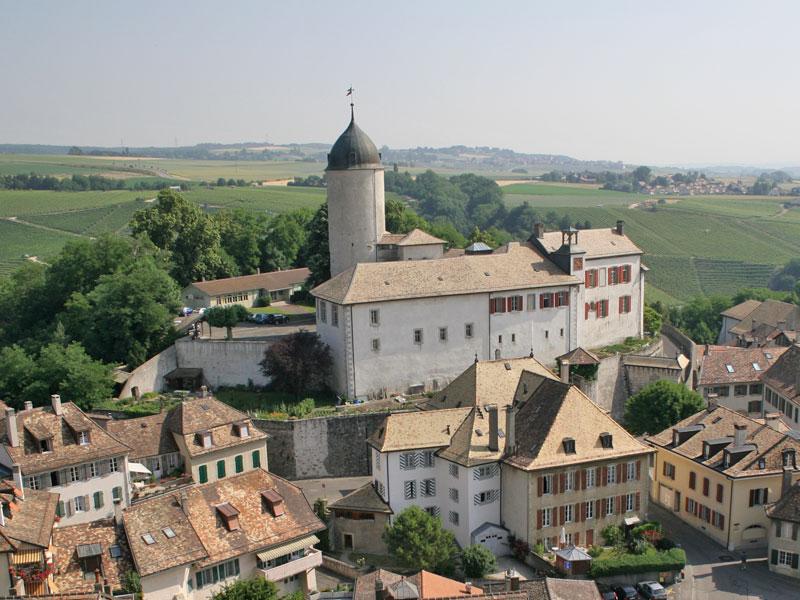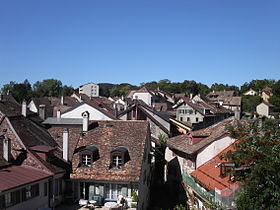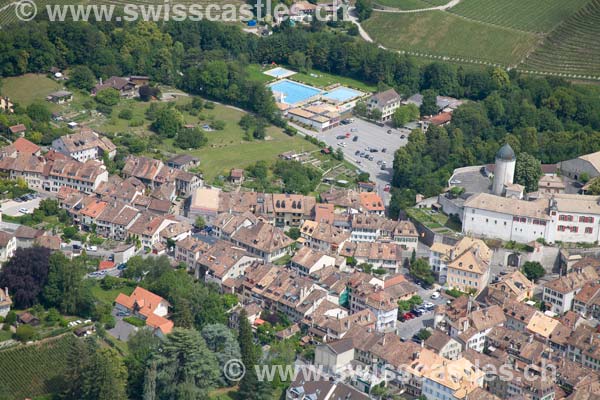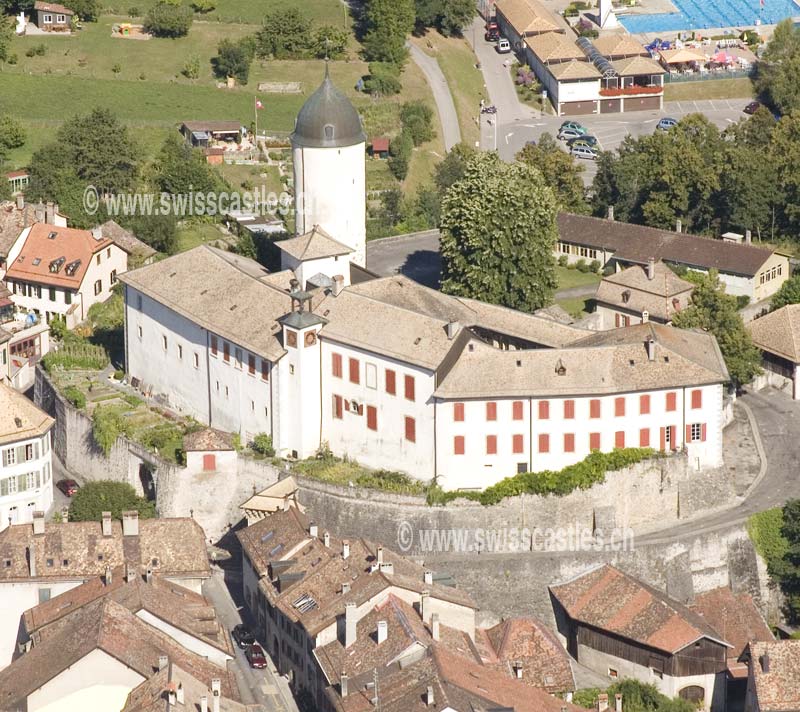Aubonne
Aubonne
Aubonne ( [ obɔn ], in the local Provençal dialect [ obuna ] ) is a municipality in the district of Morges in the canton of Vaud in Switzerland.
Geography
Aubonne is on 508 m above sea level. M., 8 km west of the district capital Morges ( straight line ). The historic town stands on a ridge above the valley of the river Aubonne, at the edge of the Jura plateau: a scenic location around 130 m above the lake level of Lake Geneva.
The area of 6.9 km ² large municipality area includes a section on the edge of the Jura plateau. The municipality extends from the ground surface at the foot of the Vaud Côte northward over the headland of Aubonne up in the deeply entrenched in the molasse of the Jura plateau of Aubonne. The eastern boundary of the municipality forms the tortuous course of Aubonne in this valley. To Aubonnes municipal area also includes the western slope of the valley and the small Seitentälchen of Armary. At the foot of the Jura plateau is 643 m above sea level. M. reached the highest elevation of Aubonne. From the municipality surface 1997 19 % came from settlements, 13 % of forest and woody plants, 67 % in agriculture and somewhat less than 1% was unproductive land.
To Aubonne include several new housing developments, the hamlet Trevelin (500 m above sea level. M. ) and Bougy -Saint -Martin ( 549 m above sea level. M. ) on the slopes of Côte well as some individual farms and since July 1, 2011, the former municipality Pizy. Neighboring communities of Aubonne are Allaman, Féchy, Essertines -sur-Rolle, Mont Herod, Saint -Livres, Lavigny and Etoy.
Population
With 3015 inhabitants ( 31 December 2012) Aubonne belongs to the medium-sized municipalities in the canton of Vaud. Of the 84.1 % inhabitants are French-speaking, German-speaking 5.2 % and 3.6 % portugiesischsprachig (as of 2000). The population of Aubonne amounted in 1850 to 1730 inhabitants, 1900 to 1736 inhabitants. After 1950 (1682 inhabitants) established a significant population increase.
Economy
Aubonne has long been an agriculturally coined town. Today, agriculture plays only a minor role as a source of income of the population. On the slope below the Cote Aubonne is an extensive wine region. On the remaining agricultural land dominates agriculture.
Because Aubonne is not at the middle of the 19th century -built railway line from Lausanne to Geneva, industrialization held relatively late collection. As the first factory on the communal land is established, the powder mill was founded in 1853 Aubonne, has been privatized since 1997. Other major companies were only added in the mid- 20th century. These include a precision foundry, the company Velcotrex SA ( Klebverschlüsse ), Serono Laboratories, furniture and pharmaceutical industries. The industrial zone is located on the plateau of the road between the motorway and the town. Most jobs are in the services available. In recent decades, the town has developed into a residential community. New residential areas have been built mainly in the west and southwest of the old town.
Tourism
As a historical town of Aubonne is a tourist attraction. It has a wood museum since 1967. In the valley of the Aubonne Canton of Vaud 1963 Switzerland 's first Arboretum at showing native and imported species on an area of around 200 hectares.
Traffic
The town has good transport links. It lies at the junction of the main roads of role to Cossonay Allaman after Gimel. The highway connection to the Aubonne opened in 1964 A1 ( Geneva -Lausanne ), which crosses the municipality, approximately 2 km from the city center.
The nearest railway station on the inaugurated on April 14, 1858 the railway line Lausanne- Geneva ( section from Morges to Coppet ) is located in Allaman just outside the municipal area. July 23 1896 to May 17, 1952 Electric Railway Allaman was after Aubonne in operation. Today Aubonne is by bus Allaman - Gimel connected to the network of public transport - Aubonne. More Postbus courses are available on the role and after Etoy.
History
The territory of Aubonne was settled very early. The oldest finds are known from the Bronze Age, from the Roman period the foundations of a villa were discovered. From the early medieval settlement originate grave finds.
The first written mention of the village was carried out in 1177 under the name Albona 1606 appeared the spelling Aulbonne. The town developed around the established in the 11th century castle of the lords of Aubonne and received in the first half of the 13th century, a defensive wall. 1255 sold to Count Peter II of Savoy castle and town. This gave the government as a fief to the family Thoire -Villars, by which it came about Grandson 1393 to the Lords of Gruyères. Aubonne was until the 15th century, the most important town in the Vaud Côte between Geneva and Lausanne. Since the 13th century weekly markets were held and since 1487 there have been two annual three-day markets.
Because the Count of Greyerz was allied with the Confederates, Aubonne was spared from the effects of the Burgundian Wars in 1476. With the conquest of Vaud by Bern in 1536, the town came under Bernese supremacy, but still belonged to 1553 the counts of Gruyères.
In the period following the rule changed hands many times. 1670 she bought the Frenchman Jean -Baptiste Tavernier, in 1685 Henri Duquesne, which they sold in 1701 Bern, which set up the same bailiwick in the previous dominion. After the collapse of the ancien régime, the town from 1798 to 1803 during the Helvetic Republic belonged to the canton of Geneva, who came up then with the enactment of the Act of Mediation in the canton of Vaud. Since 1803 Aubonne is the capital of the district of the same name.
On 1 July 2011, the former municipality Pizy merged with Aubonne, where Aubonne is also the name of the new fusion community.
Attractions
Aubonne has a picturesque medieval town with narrow streets, patrician houses from the 16th to the 19th century and the remains of the former fortifications (including two goals).
The castle, which dates back to the 11th century and consisted of two separate building complexes, it was extensively rebuilt in the 17th century. It is slightly raised on the northern edge of the old town overlooking the valley of Aubonne. The Baroque palace and the round tower with a domed roof date from 1680 Inside the palace houses an arcaded courtyard. ; courtroom with a painted ceiling of 1670th The castle has undergone in the years 1980-85 a comprehensive restoration.
The first church on the present-day municipality was in Trevelin, it was demolished in 1577. 1306 the Chapel Saint- Etienne was on the edge of the historic town and inaugurated 200 years later, the Chapel Saint -François was built right next to it. These two chapels were in 1579 included in the construction of the new parish church, which today shows a Gothic chancel and south chapel has a flamboyant with paintings from the 17th century. 1700 the heart of the French Admiral Abraham Duquesne was buried in the church of Aubonne behind a black marble slab.
In the old town there is the arcaded Hôtel de Ville, which is also called grenette. It was built in 1770-80 and served as a granary. The Maison d' Aspre, a private home with an orangery, dates from the 18th century.
Town hall
Rue Bourg de Four
Personalities
- Louis François Bégoz, (1763-1827), Minister of the Helvetic Republic










